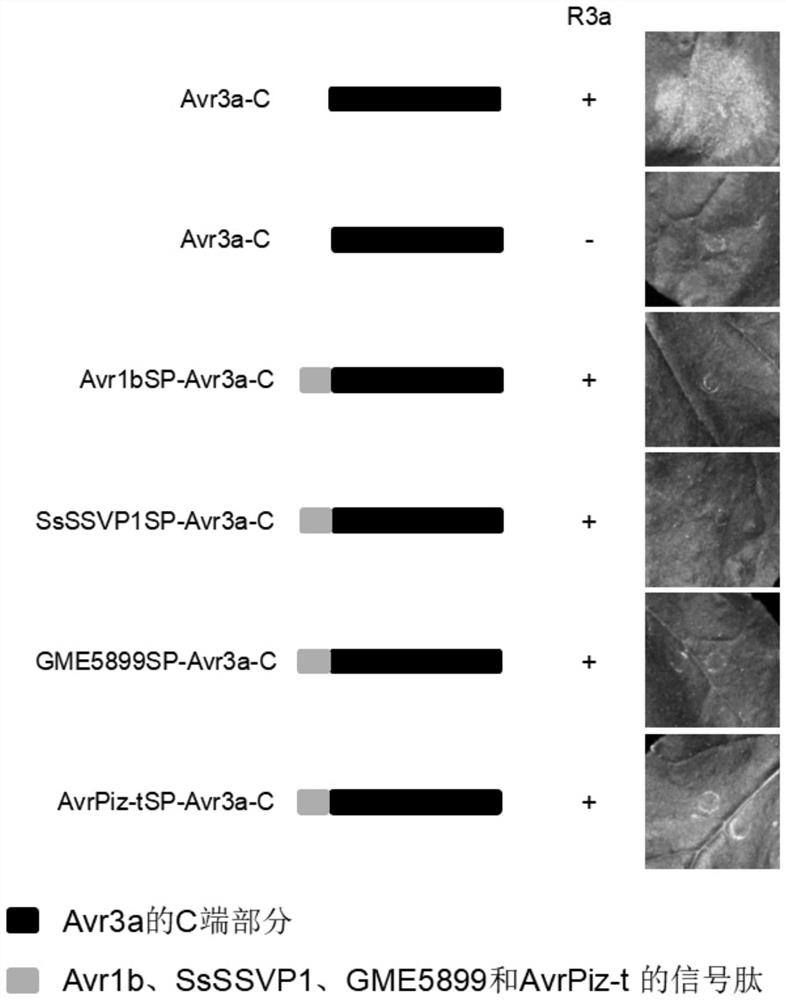A method for identifying signal peptides with secretory function using disease resistance genes to identify avirulent effector proteins
An effector protein and disease resistance gene technology, applied in genetic engineering, plant genetic improvement, botanical equipment and methods, etc., can solve the problems of cumbersome operation process, long cycle, low efficiency, etc., and achieve broad application prospects, low cost, short time effect
- Summary
- Abstract
- Description
- Claims
- Application Information
AI Technical Summary
Problems solved by technology
Method used
Image
Examples
Embodiment 1
[0023] (1) The signal peptide sequence (amino acid sequence such as SEQ ID NO.4) of the avirulent effector protein Avr1b of Phytophthora sojae and the signal peptide sequence (amino acid sequence such as SEQ ID NO.5) of the secreted protein SsSSVP1 of Sclerotinia sclerotiorum were connected respectively The C-terminal sequence of Avr3a (nucleotide sequence SEQ ID NO.2, amino acid sequence SEQ ID NO.3), constructing plant transient expression vectors, obtaining vectors that can express Avr1bSP-Avr3a-C and SsSSVP1SP-Avr3a-C on plants .
[0024] The specific process is as follows: design specific primers according to the fragment sequence, SP1bF (SEQ ID NO.8) and LapSP1b-3aR (SEQ ID NO.9) amplify the signal peptide region of Avr1b, obtain the amplification product A, LapSP1b-3aF (SEQ ID NO.9) ID NO.10) and Avr3aR (SEQ ID NO.11) amplify the C-terminal region of Avr3a to obtain amplified product B; SPSsSSVP1-F (SEQ ID NO.12) and LapSP-SsSSVP1-3aR (SEQ ID NO.13) The signal peptide ...
Embodiment 2
[0028]In order to verify the reliability of the method, the secretory function of the predicted secreted protein GME5899 in rice smut and the avirulent effector protein AvrPiz-t signal peptide in Magnaporthe grisea were selected for detection. By the method of (1) in Example 1, the GME5899 (amino acid sequence such as SEQ ID NO.6) and AvrPiz-t (amino acid sequence such as SEQ ID NO.7) signal peptide region and the C-terminal region of Avr3a are fused to construct a plant transient The expression vector is transformed into Agrobacterium by electric shock, and the Agrobacterium of the target gene expression vector is co-injected in tobacco, and it is observed whether the injection site is necrotic after 4-6 days. The occurrence of necrosis indicates that the protein cannot be secreted outside the cell, and the signal peptide has no secretion function; the absence of necrosis indicates that the protein can be secreted outside the cell, and the signal peptide has the secretion func...
PUM
 Login to view more
Login to view more Abstract
Description
Claims
Application Information
 Login to view more
Login to view more - R&D Engineer
- R&D Manager
- IP Professional
- Industry Leading Data Capabilities
- Powerful AI technology
- Patent DNA Extraction
Browse by: Latest US Patents, China's latest patents, Technical Efficacy Thesaurus, Application Domain, Technology Topic.
© 2024 PatSnap. All rights reserved.Legal|Privacy policy|Modern Slavery Act Transparency Statement|Sitemap

